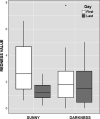The color of greater flamingo feathers fades when no cosmetics are applied
- PMID: 34707816
- PMCID: PMC8525176
- DOI: 10.1002/ece3.8041
The color of greater flamingo feathers fades when no cosmetics are applied
Abstract
Greater flamingos use cosmetic coloration by spreading uropygial secretions pigmented with carotenoids over their feathers, which makes the plumage redder. Because flamingos inhabit open environments that receive direct solar radiation during daytime, and carotenoids bleach when exposed to solar radiation, we expected that the plumage color would fade if there is no maintenance for cosmetic purposes. Here, we show that the concentrations of pigments inside feathers and on the surface of feathers were correlated, as well as that there was a correlation between the concentrations of pigments in the uropygial secretions and on the surface of feathers. There was fading in color (becoming less red) in feathers that received direct solar radiation when there was no plumage maintenance, but not so in others maintained in darkness. When we controlled for the initial color of feathers, the feathers of those individuals with higher concentration of pigments on the feather surfaces were those that lost less coloration after experimental exposure of feathers to sunny conditions. These results indicate that exposure to sunlight is correlated with the fading of feather color, which suggests that individuals need to regularly apply makeup to be more colorful. These results also reinforce the view that these birds use cosmetic coloration as a signal amplifier of plumage color. This may be important in species using highly variable habitats, such as wetlands, since the conditions experienced when molting may differ from those when the signal should be functional, usually months after molting.
Keywords: carotenoids; makeup; plumage coloration; signaling; uropygial secretions.
© 2021 The Authors. Ecology and Evolution published by John Wiley & Sons Ltd.
Conflict of interest statement
The authors declare that they have no competing interests.
Figures



Similar articles
-
Cosmetic coloration in birds: occurrence, function, and evolution.Am Nat. 2007 Jan;169 Suppl 1:S145-58. doi: 10.1086/510095. Am Nat. 2007. PMID: 19426089 Review.
-
Complex plumages spur rapid color diversification in kingfishers (Aves: Alcedinidae).Elife. 2023 Apr 21;12:e83426. doi: 10.7554/eLife.83426. Elife. 2023. PMID: 37083474 Free PMC article.
-
Annual molt period and seasonal color variation in the Eared Dove´s crown.PLoS One. 2023 Feb 24;18(2):e0280819. doi: 10.1371/journal.pone.0280819. eCollection 2023. PLoS One. 2023. PMID: 36827341 Free PMC article.
-
UV-induced feather color change reflects its porphyrin content.Naturwissenschaften. 2024 Feb 1;111(1):6. doi: 10.1007/s00114-024-01890-z. Naturwissenschaften. 2024. PMID: 38300300
-
Diversity, physiology, and evolution of avian plumage carotenoids and the role of carotenoid-protein interactions in plumage color appearance.Arch Biochem Biophys. 2015 Apr 15;572:201-212. doi: 10.1016/j.abb.2015.01.016. Epub 2015 Jan 28. Arch Biochem Biophys. 2015. PMID: 25637658 Review.
Cited by
-
The genomic architecture of continuous plumage colour variation in the European barn owl (Tyto alba).Proc Biol Sci. 2024 Jan 10;291(2014):20231995. doi: 10.1098/rspb.2023.1995. Epub 2024 Jan 10. Proc Biol Sci. 2024. PMID: 38196365 Free PMC article.
References
-
- Amat, J. A. , Garrido, A. , Portavia, F. , Rendón‐Martos, M. , Pérez‐Gálvez, A. , Garrido‐Fernández, J. , Gómez, J. , Béchet, A. , & Rendón, M. A. (2018). Dynamic signalling using cosmetics may explain the reversed sexual dichromatism in the greater flamingo. Behavioral Ecology and Sociobiology, 72, 135. 10.1007/s00265-018-2551-1 - DOI
-
- Amat, J. A. , & Rendón, M. A. (2017). Flamingo coloration and its significance. In Anderson M. J. (Ed.), Flamingos: Behavior, biology, and relationship with man (pp. 77–95). Nova Scientific Publishers.
-
- Amat, J. A. , Rendón, M. A. , Garrido‐Fernández, J. , Garrido, A. , Rendón‐Martos, M. , & Pérez‐Gálvez, A. (2011). Greater flamingos Phoenicopterus roseus use uropygial secretions as make‐up. Behavioral Ecology and Sociobiology, 65, 665–673. 10.1007/s00265-010-1068-z - DOI
-
- Blanco, G. , Frías, O. , Garrido‐Fernández, J. , & Hornero‐Méndez, D. (2005). Environmental‐induced acquisition of nuptial plumage expression: A role of denaturation of feather carotenoproteins? Proceedings of the Royal Society B: Biological Sciences, 272, 1893–1900. 10.1098/rspb.2005.3157 - DOI - PMC - PubMed
Associated data
LinkOut - more resources
Full Text Sources

